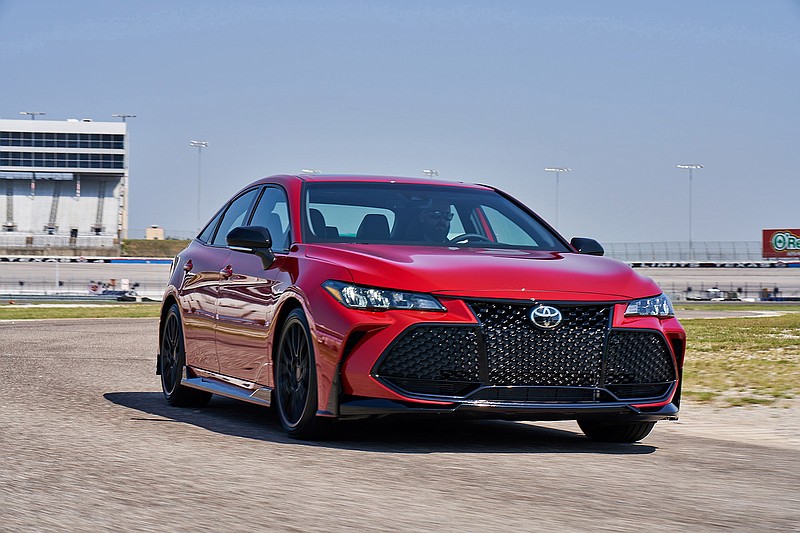Oh, sure, she's a real looker but my bias was to think her foolish, bedecked in useless ornaments. Then I pushed the start button.
A sweet, Asiatic burble from the exhaust let me know that the 2020 Toyota Avalon TRD was a little different offering in a product line that is the runaway choice as the best entry-level luxury sedan in the solar system.
A late-night run through a vacant interstate stretch and down favorite backroads convinced me that Toyota Racing Development just turned the Avalon into one of the sweetest-driving large cars these ink-stained hands have ever touched. Instead of TRD, they oughta put GT on this thing.
Oh, it's not as lush or powerful as a $60,000 Audi A6, but at $42,385 the Avalon TRD will go faster and do more things than most of us are foolish enough to try. And it's a Toyota, meaning free maintenance the first two years and a car that stays out of the shop for many years thereafter.
And it's an Avalon, the best car Toyota sells, which means premium comfort and safety.
More than skin deep
To be honest, when I saw the paperwork a few days before the car arrived, my first thought that the TRD logo meant just another trim package, plus a few things I consider useless on large, luxury cars, like stiffer shocks, bigger wheels and narrower tires that serve only to make harsh Avalon's expertly engineered and accommodating ride.
Such foolishness.
It turns out, however, that the TRD team made substantial changes to the car's undercarriage and tuned them while doing extensive on-track testing. They made the car stronger, stiffer, and lower.
Thicker underbody braces increased torsional rigidity and unique coil springs lowered the vehicle 0.6 inches for a reduced center of gravity. Stiffer coil springs and larger stabilizer bars increased roll stiffness 44% upfront and 67% in the rear. Black alloy wheels reduced unsprung mass by 19 pounds.
Front brakes went from 12 inches to 13 with dual-piston, instead of single-piston calipers.
Body upgrades give the car a sleeker, more adventurous look and improve stability at speed. The body kit includes a front splitter, side aero skirts, trunk lid spoiler, and rear diffuser.
The TRD team did not touch the engine, a smooth and powerful, 301-hp, double-overhead-cam, 24-valve V-6. It's from the GR series of engines Toyota and Lexus have used in a wide array of applications since the turn of the century. The 60-degree angle of each piston means the weight on each side of the engine is nearly identical at each phase of the stroke, reducing vibration and harshness.
The TRD engineers added a cat-back exhaust to the Avalon. Absent significant upgrades to air intake or electronic command module, however, the benefits are more qualitative than quantitative. Reducing back pressure may make the engine run a little more smoothly, and it certainly produces a lovely sound, especially under heavy throttle. It's not a thunderous, punch-you-in-the-nose bass note; more like a confident, break-the-board second tenor.
Though Toyota does not make available the dimensions or effects of the exhaust system, we would like an explanation of why it shot past its supposedly 112-mph-governed top speed.
Different ride and drive
Having just spent a week in the company of the Avalon's brother, a Lexus ES, which rides on the same platform, we were able to draw some distinction between the two vehicles' ride and handling.
The Lexus has a significantly gentler ride, insulating the cabin from uneven tarmac remarkably well. The Avalon TRD has a stiffer ride, but it is not unpleasant, just more attuned to the road. It is certainly more refined than, say, the Kia Stinger.
One could see younger drivers finding enjoyment in the sense of feedback and readiness for action, but Beautiful Blonde and I, both official geezers, both loved scooting around town in the car.
Pushed hard through sweeping curves, the Avalon TRD has crisper turn-in but, surprisingly, more body roll. The base suspension system, which is electronically adaptive to balance pitch and roll forces, seems to keep the car more level.
This is not to say the Avalon TRD is unsafe, but the amount of body lean prompted us to lighten up on the throttle. Let's just not say the car is sporty, but not a sports car.
Quality throughout
Assembled in Kentucky, the Avalon earns its laurels as Toyota's flagship with superior materials and impeccable fit-and-finish throughout. Seats are supportive, switches and gauges easy to see and understand.
The level of interior design and comfort reaches a new level in the fifth-generation Avalon.
Thin pillars and a broad windshield lend to the wide, open feeling for passengers in the front and back. Rear seat roominess, long an Avalon hallmark, is again present with ample shoulder-, leg- and headroom. In the driver's line of sight, a 7-inch Multi-Information Display shows vehicle information, turn-by-turn navigation, and various vehicle settings relating to its extensive technology.
Safety first
Like all Toyotas, the Avalon comes standard with a complete suite of driver-assist technology, as well as a long list of passive safety features. It earns top marks in independent safety ratings.
Bottom line
The Toyota Avalon is everybody's top-rated large car for many good reasons. Now Toyota is reaching out to younger buyers with one that is sportier but still comfortable and luxurious. Best of all, it's a hoot to drive.

